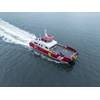False Alarm, Loss of Propulsion Leads to Cargo Ships Colliding
A loss of propulsion due to a false alarm led to cargo vessels colliding near Port Arthur, Texas last year, the National Transportation Safety Board (NTSB) said Thursday.
While transiting the Sabine Pass on August 21, 2022, the general cargo ship Damgracht lost propulsion when the vessel’s main engine shut down due to “high oil mist density” sensed by its oil mist detector (OMD). Due to the abrupt loss of propulsion, the Damgracht began veering into the path of the bulk carrier AP Revelin. The pilot aboard the Damgracht took steps to notify and avoid the AP Revelin, but without the means to maneuver the vessel, the Damgracht and the AP Revelin collided. No injuries were reported. The collision resulted in $3.4 million in damages to the AP Revelin.
The day before the collision, the Damgracht’s main engine alarmed and shortly later shut down due to a high cooling water temperature. That evening, the engine crew cooled down the main engine and repaired a failed cylinder head gasket. The gasket failure likely allowed cooling water to leak into the cylinder and contaminate the engine’s lube oil system, and the work to repair it resulted in the interior sections of the engine being exposed to humid conditions. That evening the humidity averaged about 90%. It is likely that higher levels of water entered the crankcase than could be removed overnight by the lube oil purifier or evaporate from the heat of the running engine in the short time it was tested post-repair. While the Damgracht was underway the following morning, the OMD triggered a false alarm after sensing water vapor that had condensed in the sample.
The NTSB determined the probable cause of the collision was the Damgracht’s loss of propulsion caused by an automatic shutdown of the main engine due to a false alarm, likely triggered by water vapor sensed by the oil mist detector shortly after engine maintenance was completed to replace a failed cylinder head gasket during high-humidity conditions.
“When certain engine components, such as cylinder head gaskets, fail, cooling water can be introduced into engine lube oil systems. Ambient air conditions, such as high humidity or extreme cold temperatures, can also increase the water content within engine lube oil sumps,” the report said. “The elevated quantity of water in lube oil systems can trigger false alarms in engine crankcase oil mist detectors (and lead to an engine shutdown), due to water droplets passing through the measuring track or the filter glass detecting condensation (mistaking it for oil mist). After an engine’s crankcase is opened and exposed to these conditions during maintenance and repair, it is good practice for engine crews to inspect and test the lubricating oil system for water intrusion and ensure lube oil purifying equipment is functioning properly to remove any water or other contamination in the lube oil.”













